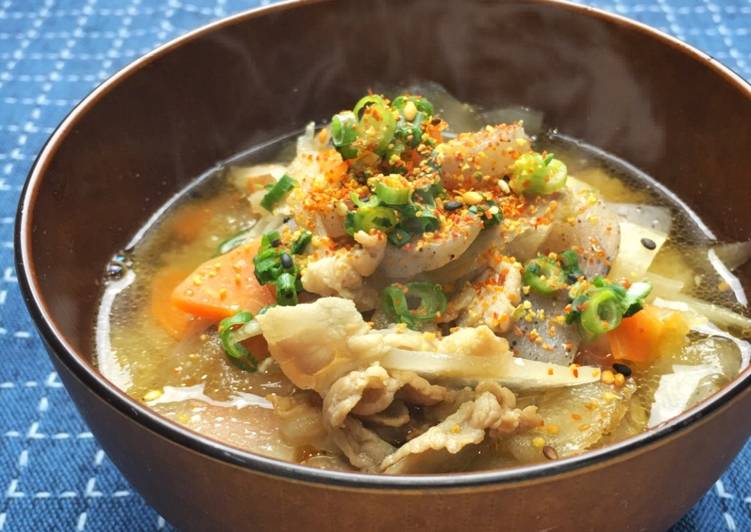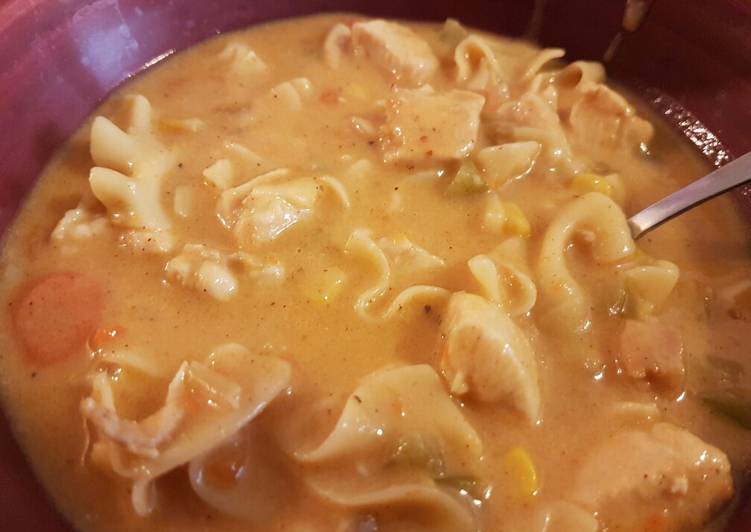
Hey everyone, it’s Drew, welcome to our recipe page. Today, we’re going to prepare a special dish, tonjiru (pork miso soup). One of my favorites. This time, I will make it a little bit tasty. This will be really delicious.
Tonjiru (Pork miso soup) is one of the most well liked of recent trending foods in the world. It’s simple, it is fast, it tastes delicious. It is appreciated by millions every day. They are fine and they look wonderful. Tonjiru (Pork miso soup) is something which I have loved my entire life.
Tonjiru (豚汁), literally meaning "pork (ton) soup (jiru)", is basically miso soup featuring pork and root vegetables. Some people call it Butajiru (豚汁) too, just another way to read the same kanji character. It may be a cold-weather staple, but I do enjoy the soup year-round. Tonjiru (豚汁) is a hearty miso soup with pork slices and vegetables.
To get started with this recipe, we have to first prepare a few ingredients. You can cook tonjiru (pork miso soup) using 11 ingredients and 14 steps. Here is how you can achieve that.
The ingredients needed to make Tonjiru (Pork miso soup):
- Get 200 g thinly sliced pork belly
- Make ready 200 g daikon radish
- Get 100 g carrot
- Make ready 150 g burdock root
- Get 150 g konnyaku
- Take 1 spring onion
- Get 120 ml dashi stock
- Make ready 100 g miso
- Make ready 2 teaspoon soy sauce
- Get Thinly sliced green onion (garnish)
- Prepare 7 spice chili power (optional)
This dish is great to make in a big batch and feed your family something delicious and nutritious. Tonjiru or Butajiru (豚汁,とん汁,とんじる) — both literally mean pig/pork soup — is a Japanese soup made with pork and vegetables, flavoured with miso. Compared to normal miso soup, tonjiru tend to be more substantial, with a larger quantity and variety of ingredients added to the soup. Tonjiru (or Butajiru) is a kind of Miso Soup with pork and a lot of root vegetables such as Gobo (burdock root) and carrot.
Steps to make Tonjiru (Pork miso soup):
- Peel the dikon radish and carrot.
- Cut the dikon radish and carrot into quarters lengthwise and then cut into thin slices.
- Wash the burdock root well, then scrape the skin with the back of a knife. Don’t peel the burdock too much as the part just under the skin contains a lot of nutrients and flavor.
- Make several long shallow cuts lengthwise all the way around the burdock root.
- Shave the burdock root into small strips over cold water and soak them for about 5 minutes to remove bitterness, then drain.
- Cut spring onion into 2 cm long pieces.
- Cut the konnyaku into thin short strips.
- Cut the pork belly into 3 cm thick slices.
- Heat the pan over medium-high heat, place vegetable oil and then add the pork and sauté well.
- Add the dikon, carrot, burdock root, spring onion and konnyaku and stir-fry.
- Once the fat from the pork is evenly coating the vegetables, add the dashi stock and simmer, skimming occasionally.
- Once the vegetables become tender, add the miso by dissolving it in a miso strainer or a ladle with some of the soup until no lumps remain.
- Add a 1 teaspoon of soy sauce.
- Serve the miso soup in a bowl, and then sprinkle thinly sliced green onion and seven spice chili powder (shichimi tougarashi) according to your preference.
Compared to normal miso soup, tonjiru tend to be more substantial, with a larger quantity and variety of ingredients added to the soup. Tonjiru (or Butajiru) is a kind of Miso Soup with pork and a lot of root vegetables such as Gobo (burdock root) and carrot. Even though it is a Miso soup, Tonjiru tastes very different from ordinary Miso Soup. Tonjiru has a distinct pork flavor and strong taste from Gobo. Dissolve the miso and soy sauce mixture slowly into the soup in the pot using.
So that’s going to wrap this up with this exceptional food tonjiru (pork miso soup) recipe. Thanks so much for your time. I’m sure you can make this at home. There’s gonna be interesting food in home recipes coming up. Remember to bookmark this page in your browser, and share it to your family, friends and colleague. Thank you for reading. Go on get cooking!

